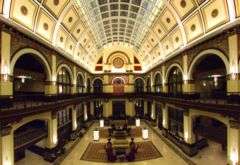Union Station (Nashville)
|
Nashville Union Station and Trainshed | |
|
Image of Union Station in 2008 taken at street level showing the major architectural features of what is now a hotel | |
| Location |
Broadway and 10th Ave. Nashville, Tennessee |
|---|---|
| Coordinates | 36°09′26″N 86°47′05″W / 36.1572°N 86.7848°WCoordinates: 36°09′26″N 86°47′05″W / 36.1572°N 86.7848°W |
| Architect | Richard Montfort |
| NRHP Reference # | 69000178 |
| Significant dates | |
| Added to NRHP | December 30, 1969 |
| Designated NHL | 1975 |
| Delisted NHL | July 31, 2003 |

Nashville's Union Station[1] is a former railroad terminal, now hotel, opened in 1900 to serve the passenger operations of the eight railroads then providing passenger service to Nashville, Tennessee. Built just to the west of the downtown area, its design placed it to the east and above a natural railroad cut through which most of the tracks of the area were routed which was spanned by a viaduct adjacent to the station. The station was also served by streetcars prior to their discontinuance in Nashville in 1941.
History and architecture
The station is an example of late-Victorian Romanesque Revival architecture and is highly castellated. The tower originally contained an early mechanical digital clock; when replacement French silk drive belts proved unavailable during World War I, it was replaced by a traditional analog clock. The tower was originally topped by a bronze statue of the Roman god Mercury; this was toppled in a storm in 1951. When a new Main Post Office was built in Nashville in 1935, it was located adjacent to Union Station. A connecting passageway between the two served to transport mail to and from trains for over three decades.
The station reached peak usage during World War II when it was the shipping-out point for tens of thousand of U.S. troops and the site of a USO canteen. It started a long decline shortly thereafter as passenger rail service in the U.S. generally went into decline. By the 1960s it was served by only a few trains daily. Much of its open spaces were roped off and its architectural features became largely the habitation of pigeons. The formation of Amtrak in 1971 reduced service to the northbound and southbound Floridian train each day. When this service was discontinued in October 1979, the station was abandoned entirely.
Redevelopment
The station fell into the custody of the United States Government's General Services Administration, which struggled for years to find a viable redevelopment plan as the station declined further. It was listed on the National Register of Historic Places and had a tremendous sentimental appeal to many Nashvillians who categorically rejected any redevelopment plans which did not involve the retention of the main terminal building. In the early 1980s a group of investors came forward with a plan to finance the renovation of the station into a luxury hotel which was approved.
The hotel plan was based around the use of "junk bond" financing; the interest payments required were so severe that the hotel would require 90% occupancy at an average room rate of $135/night to break even. This was not supportable in the 1980s Nashville hotel market and the initial investors soon found the project to be bankrupt. Many feared that this meant that the station was doomed; however, the new investor group who bought the hotel out of bankruptcy were able to operate it profitably because they had a much lower cost basis in it and were not forced to charge such exorbitant room rates or project such a high occupancy rate. By the mid-1990s they had restored Mercury to his place atop the tower, albeit in a two-dimensional form painted in trompe l'oeil style to replicate the original. This was destroyed in the 1998 downtown Nashville tornado but was soon replaced.
More problematic was the attempt to find a modern use for the massive train shed adjacent to the terminal building, where the passengers actually met the trains. The structure, said to be the largest of its kind in the world and an engineering masterpiece, continued to deteriorate as its fate was debated. Plans, including those involving raising it up to the level of the surrounding street (from the cut level) and making it into a farmers' market, never came to fruition. The structure was eventually demolished in late 2000 after a fire damaged the shed, and no viable preservation alternatives were identified. Its design had been carefully recorded.
Today
As of October 2015, the station is a part of Marriott International's Autograph Collection Hotels. The "AAA Four Diamond Award" hotel offers 125 classic or premium rooms, including 12 suites[2]
See also
- Dixiana (passenger train)
- Dixie Flagler
- Humming Bird (passenger train)
- Pan-American (passenger train)
- Tennessean (passenger train)
References
- ↑ Hotel Website Archived February 9, 2008, at the Wayback Machine.
- ↑ "Our Hotel". unionstationhotelnashville.com. Retrieved 19 October 2015.